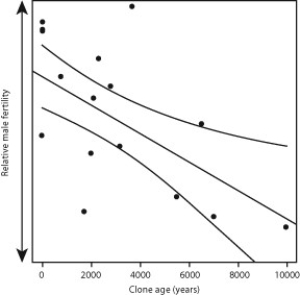Multiple Choice
Plants differ from many animals because they undergo indeterminate (continual) growth. Indeterminate growth is common in clonal plants because a single clone can continually produce new clones without undergoing sexual reproduction, even if the plant is capable of doing so.
Senescence, an inability to undergo cell division as an organism ages, also occurs in many plants and animals. However, scientists have had a difficult time establishing the occurrence of senescence in cloning plants because of their indeterminate growth patterns. Mutations in somatic cells are common during asexual growth, and these mutations lead to a decrease in sexual fitness. Scientists hypothesize that over time, as these mutations accumulate, they may contribute to senescence in clonal plants. To test this theory, scientists studied a naturally growing population of trembling aspen (Populus tremuloides) , a tree species that grows clones from its root system but is capable of sexual reproduction. To determine if trembling aspens senesce, they compared genetic data of estimated tree age with the variable of "diminishing fertility": the amount of pollen released by male aspen trees. Here are the results for this part of the study:
 Source: Adapted from Ally, D., Ritland, K., & Otto, S. P. (2010) . Aging in a long-lived clonal tree. PLoS Biol, 8(8) : e1000454. doi:10.1371/journal.pbio.1000454.
Source: Adapted from Ally, D., Ritland, K., & Otto, S. P. (2010) . Aging in a long-lived clonal tree. PLoS Biol, 8(8) : e1000454. doi:10.1371/journal.pbio.1000454.
-If a male trembling aspen clone loses its ability to produce pollen, how is its reproduction capability affected?
A) The clone will have a greater opportunity of sexual reproduction with female trembling aspen trees.
B) The clone can continue to clone itself, but it will be unable to undergo sexual reproduction.
C) The clone will only be able to reproduce through fragmentation.
D) The clone will begin to produce pine cones with enlarged ovaries.
Correct Answer:

Verified
Correct Answer:
Verified
Q2: What event that occurred around 10,000 years
Q3: What happens to the cotyledons of pea
Q4: How many chromosomes are there in an
Q5: Which statement is false?<br>A) Stalks of celery
Q6: Plants differ from many animals because they
Q7: Which part of this root tip is
Q8: The part of corn that is used
Q9: Angiosperms consist of the clades<br>A) cycads and
Q10: What helps regulate the movement of carbon
Q11: A seed develops from a(n)<br>A) pollen grain.<br>B)